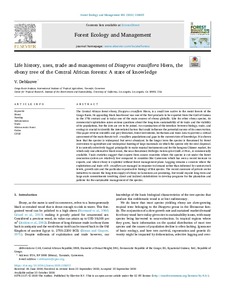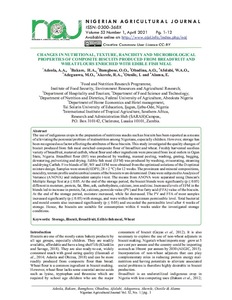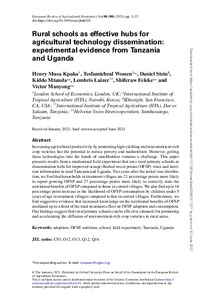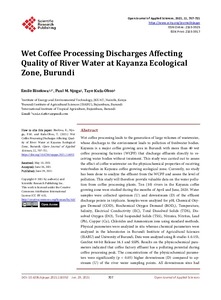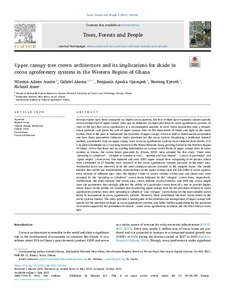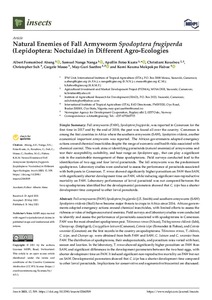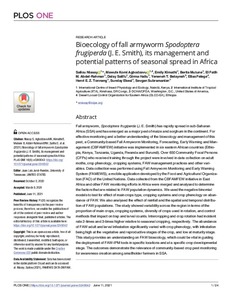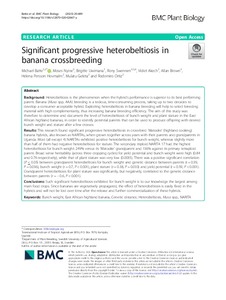Welcome to the International Institute of Tropical Agriculture Research Repository
Journal and Journal Articles: Recent submissions
Now showing items 1041-1060 of 5271
-
Genetic diversity and population structure analysis of bambara groundnut (Vigna subterrenea L) landraces using DArT SNP markers
(2021)Understanding the genetic structure and diversity of crops facilitates progress in plant breeding. A collection of 270 bambara groundnut (Vigna subterrenea L) landraces sourced from different geographical regions (Nigeria/Cameroon, West, Central, Southern and East Africa) and unknown origin (sourced from United Kingdom) was used to assess genetic diversity, relationship and population structure using DArT SNP markers. The major allele frequency ranged from 0.57 for unknown origin to 0.91 for West ... -
Life history, uses, trade and management of Diospyros crassiflora Hiern, the ebony tree of the central African forests: a state of knowledge
(2021)The Central African forest ebony, Diospyros crassiflora Hiern, is a small tree native to the moist forests of the Congo Basin. Its appealing black heartwood was one of the first products to be exported from the Gulf of Guinea in the 17th century and is today one of the main sources of ebony globally. Like for other ebony species, its commercial exploitation raises serious questions about the long-term sustainability of its trade and the viability of its populations, but the dots are yet to be ... -
Can black soldier fly larvae-Desmodium intortum based diets enhance the performance of Cobb500(R) broiler chickens and smallholder farmers' profit in Kenya?
(2021-02)This study aimed to evaluate the performance of broiler chickens fed on 3 black soldier fly larvae (BSFL) (Hermetia illucens) and Greenleaf desmodium (Desmodium intortum)-based meals. We evaluated growth performance, carcass quality, and profitability under various commercial pathways (doorstep, retail, whole, and assorted). Desmodium and BSFL powders were formulated into 3 ratios: T1 25:75, T2 50:50, and T3 75:25. A commercial feed was used as a control. One hundred and twenty mixed-sex 1-day-old ... -
Sources of resistance to Pseudocercospora fijiensis, the cause of black Sigatoka in banana
(2021)Black Sigatoka, caused by Pseudocercospora fijiensis, is one of the most devastating diseases of banana. In commercial banana-growing systems, black Sigatoka is primarily managed by fungicides. This mode of disease management is not feasible for resource-limited smallholder farmers. Therefore, bananas resistant to P. fijiensis provide a practical solution for managing the disease, especially under smallholder farming systems. Most banana and plantain hybrids with resistance to P. fijiensis were ... -
Morphological characterization and genotypic identity of African yam bean (Sphenostylis stenocarpa Hochst ex. A. Rich. Harms) germplasm from diverse ecological zones
(2021)African yam bean (AYB) is an affordable protein source capable of diversifying the food base in sub-Saharan Africa. However, research efforts made towards the crop's improvement and in expanding production are limited. This study characterized 169 AYB accessions at Jimma, Ethiopia, using 31 phenotypic characters. The analysis of variance revealed highly significant (P < 0.01) differences for days to 50% flowering, days to first flowering, leaf area, number of seeds per pod, pod length, seed ... -
Changes in nutritional, texture, rancidity and microbiological properties of composite biscuits produced from breadfruit and wheat flours enriched with edible fish meal
(2021)The use of indigenous crops in the preparation of nutritious snacks such as biscuits has been reported as a means of alleviating the perennial problem of malnutrition among Nigerians, especially children. However, storage has been recognised as a factor affecting the attributes of these biscuits. This study investigated the quality changes of biscuit produced from fish meal enriched-composite flour of breadfruit and wheat. Freshly harvested seedless variety of breadfruit, matured catfish, wheat ... -
Genome-wide association studies for sex determination and cross-compatibility in water yam (Dioscorea alata L.)
(2021)Yam (Dioscorea spp.) species are predominantly dioecious, with male and female flowers borne on separate individuals. Cross-pollination is, therefore, essential for gene flow among and within yam species to achieve breeding objectives. Understanding genetic mechanisms underlying sex determination and cross-compatibility is crucial for planning a successful hybridization program. This study used the genome-wide association study (GWAS) approach for identifying genomic regions linked to sex and ... -
Rural schools as effective hubs for agricultural technology dissemination: experimental evidence from Tanzania and Uganda
(2021)Increasing agricultural productivity by promoting high-yielding and micronutrient-rich crop varieties has the potential to reduce poverty and malnutrition. However, getting these technologies into the hands of smallholders remains a challenge. This paper presents results from a randomised field experiment that uses rural primary schools as dissemination hubs for improved orange-fleshed sweet potato (OFSP) vines and nutrition information in rural Tanzania and Uganda. Two years after the initial ... -
Seed set patterns in east African highland cooking bananas are dependent on weather before, during and after pollination
(2021)Seed set in banana is influenced by weather, yet the key weather attributes and the critical period of influence are unknown. We therefore investigated the influence of weather during floral development for a better perspective of seed set increase. Three East African highland cooking bananas (EAHBs) were pollinated with pollen fertile wild banana ‘Calcutta 4′. At full maturity, bunches were harvested, ripened, and seeds extracted from fruit pulp. Pearson’s correlation analysis was then conducted ... -
Wet coffee processing discharges affecting quality of river water at Kayanza ecological zone, Burundi
(2021-06)Wet coffee processing leads to the generation of large volumes of wastewater, whose discharge to the environment leads to pollution of freshwater bodies. Kayanza is a major coffee growing area in Burundi with more than 40 wet coffee processing factories (WCPF) that discharge effluents directly to receiving water bodies without treatment. This study was carried out to assess the effect of coffee wastewater on the physicochemical properties of receiving waterbodies in Kayanza coffee growing ecological ... -
The feasibility of using pulsed-vacuum in stimulating calcium-alginate hydrogel balls
(2021-07-01)The effect of the pulsed-vacuum stimulation (PVS) on the external gelation process of calcium-alginate (Ca-Alg) hydrogel balls was studied. The process was conducted at four different working pressures (8, 35, 61, and 101 kPa) for three pulsed-vacuum cycles (one cycle consisted of three repetitions of 10 min of depressurization and 10 min of vacuum liberation). The diffusion coefficients (D) of calcium cations (Ca2+) gradually reduced over time and were significantly pronounced (p < 0.05) at the ... -
Upper canopy tree crown architecture and its implications for shade in cocoa agroforestry systems in the western region of Ghana
(2021-09)everal studies have been conducted on shaded cocoa systems, but few of these have examined species-specific crown architecture of upper canopy trees and its influence on shade provision in cocoa agroforestry systems. In view of the fact that cocoa agroforestry is a recommended practice to drive cocoa production onto a climate-smart pathway, and given the role of upper canopy trees in the moderation of shade and light to the cocoa system, there is the need to understand the dynamics of upper canopy ... -
Natural enemies of fall armyworm Spodoptera frugiperda (Lepidoptera: Noctuidae) in different agro-ecologies
(2021)Fall armyworm (FAW) Spodoptera frugiperda (J.E. Smith) and southern armyworm (SAW) Spodoptera eridania (Stoll) have become major threats to crops in Africa since 2016. African governments adopted emergency actions around chemical insecticides, with limited efforts to assess the richness or roles of indigenous natural enemies. Field surveys and laboratory studies were conducted to identify and assess the performance of parasitoids associated with spodopterans in Cameroon. FAW was the most abundant ... -
Bioecology of fall armyworm Spodoptera frugiperda (J. E. Smith), its management and potential patterns of seasonal spread in Africa
(2021)Fall armyworm, Spodoptera frugiperda (J. E. Smith) has rapidly spread in sub-Saharan Africa (SSA) and has emerged as a major pest of maize and sorghum in the continent. For effective monitoring and a better understanding of the bioecology and management of this pest, a Community-based Fall Armyworm Monitoring, Forecasting, Early Warning and Management (CBFAMFEW) initiative was implemented in six eastern African countries (Ethiopia, Kenya, Tanzania, Uganda, Rwanda and Burundi). Over 650 Community ... -
Mycotoxin profiles of solar tent-dried and open sun-dried plantain chips
(2021)Plantain is a popular dietary staple in Central and West African countries due to its versatility and excellent nutritional value. Mature unripe plantain finger is usually processed into dried chips by processors using open sun-drying method to reduce the moisture content and extends its shelf life, but without controlling the unit operations that affect product quality. Thus, this study aimed at assessing the mycotoxin profile of solar tent-dried and open sun-dried plantain chips in Nigeria. Fifty ... -
Edible crickets (Orthoptera) around the world: distribution, nutritional value, and other benefits - a review
(2021)Edible crickets are among the praised insects that are gaining recognition as human food and livestock feed with a potential of contributing to food security and reduction of malnutrition. Globally, the sustainable use of crickets as food or feed is undermined by lack of information on the number of the edible crickets, the country where they are consumed, and the developmental stages consumed. Furthermore, lack of data on their nutritional content and the potential risks to potential consumers ... -
Dataset on influence of drying variables on properties of cassava foam produced from white- and yellow-fleshed cassava varieties
(2021-08)Freshly harvested cassava has a tendency to deteriorate rapidly in its physiological properties after harvest. Therefore, cassava is often processed using a number of unit operations in order to derive a stable, storable product of acceptable eating quality. Among the unit operations employed, drying is considered as one of the oldest and most important process in arresting deterioration of cassava. In recent times, more researchers are considering foam mat drying as a drying technique for tuber ... -
Significant progressive heterobeltiosis in banana crossbreeding
(2020)Background Heterobeltiosis is the phenomenon when the hybrid’s performance is superior to its best performing parent. Banana (Musa spp. AAA) breeding is a tedious, time-consuming process, taking up to two decades to develop a consumer acceptable hybrid. Exploiting heterobeltiosis in banana breeding will help to select breeding material with high complementarity, thus increasing banana breeding efficiency. The aim of this study was therefore to determine and document the level of heterobeltiosis ... -
Digital extension, price risk, and farm performance: experimental evidence from Nigeria
(2021)Despite decades of investment in agricultural extension, technology adoption among farmers and agricultural productivity growth in Sub-Saharan Africa remain slow. Among other shortcomings, extension systems often make recommendations that do not account for price risk or spatial heterogeneity in farmers' growing conditions. However, little is known about the effectiveness of extension approaches for nutrient management that consider these issues. We analyze the impact of farmers' access to ... -
Transgenic expression of dsRNA targeting the Pentalonia nigronervosa acetylcholinesterase gene in banana and plantain reduces aphid populations
(2021)The banana aphid, Pentalonia nigronervosa, is the sole insect vector of banana bunchy top virus (BBTV), the causal agent of banana bunchy top disease. The aphid acquires and transmits BBTV while feeding on infected banana plants. RNA interference (RNAi) enables the generation of pest and disease-resistant crops; however, its effectiveness relies on the identification of pivotal gene sequences to target and silence. Acetylcholinesterase (AChE) is an essential enzyme responsible for the hydrolytic ...


